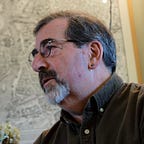Kingdom Maps: Drawing the Boundary Between Us and Them
Part 5 in a series on global information design explores historical maps that superimpose political influence onto physical space
2.2 Kingdom Maps
A Kingdom Map superimposes political influence onto physical space to represent that part of the world within a government’s control. Its function is to show us the shape and extent of how “our” territory is separate from “their” territory. We see the adjacent lands that are not ours, often without detail, but we do not see what lies far beyond.
While we find visualizations of the known world in many cultures, the examples of visualizing kingdoms cluster around Western territorial aspirations. That image of “our” territory is compelling when it expresses a sense of wholeness, a coherent imperial space without interruption. Conversely, it is visually disturbing to see a piece taken out of “our” wholeness, a boundary interrupted, or a narrow area precariously surrounded by “their” territory. To visualize the kingdom, I will begin with a series of anthropomorphic and zoomorphic maps from 16th-century Europe.
The Metaphoric Kingdom
Most of us have internalized Europe’s large physical boundaries to formulate our concept of the continent. This conditions us to expect the Atlantic Ocean to the west, the Mediterranean Sea to the south, and the Arctic region to the north…
